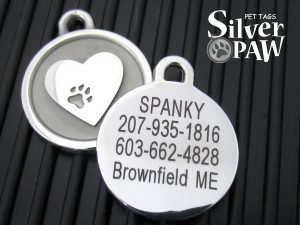 There are three basic approaches to applying information to pet id tags. If you are reading this, I’m assuming you are looking for the best type of engraving to purchase on your pet tag.
There are three basic approaches to applying information to pet id tags. If you are reading this, I’m assuming you are looking for the best type of engraving to purchase on your pet tag.
Computerized rotary engravers use a sharp cutter to actually remove metal from the surface of lines. Stamping machines exert tremendous force to press numbers and letters into metal, thereby displacing the lines into the metal. Computerized lasers can mark or engrave metal using a highly focused laser beam. Here at Silver Paw we are most concerned with what will be the most readable, durable, and the longest lasting for you and your pet.
Computerized rotary engravers carve out metal from the surface. Stainless steel tags are highly durable but a tough metal to engrave this way. Often times the engraving is not very deep because the cutter doesn’t have enough power to cut through the metal. It wreaks havok on carbide cutters. Cutters must constantly be sent to the machine shop for re-sharpening because the stainless steel wears them down so quickly. You will find softer metal tags can be easily engraved this way but the engraving wears away quickly along with the tag metal surface itself. This method is also harder to read as it requires you to move the tag around to actually see the embedded engraving.
Stamping pet id tags makes for a nice deep indentation of information on the tag but it is not always the most attractive. It is impossible to get a lot of information placed in a small space, such as a pet tag, in a crisp and readable manner because the displaced metal has to have somewhere to go. It will last, but if your dog is really active, the tag will not last. Stamping is done on thin, soft metal (brass, copper, nickel, pewter, aluminum, sterling silver). These metals are too soft to withstand the abuse a tag takes. Stamping personalized information on thick stainless steel uses expensive dies, cannot be done without an enormous amount of pressure (tons), and is therefore impractical.
Laser engraving pet id tags has become very popular and it is what we use here at Silver Paw Tags. Lasers engrave metal using a highly focused laser beam. At one time CO2 lasers were not a good option for engraving metal because they weren’t powerful enough to produce deep lines. With the advent of fiber pulsed lasers that scenario has changed. A powerful, costly, fiber laser is the only type of laser which can get deep into stainless steel. The laser actually vaporizes the metal and leaves a deep carbon blackened line which makes the marking very crisp and easy to read. Laser engraving is very sharp and clean. The extent of detail it can achieve is amazing.

 Brownfield jeweler, Karen Twombly, isn’t giving up. With 19 years of business under her belt and gold and silver prices through the roof, Twombly, is reinventing herself. “ I’ve had plenty of time, sitting at shows, to ponder the fate of jewelry in a less than thriving economy.” Spurred on by her trusty canine companions, Ruby and Jet, her new business, Silver Paw Pet Tags, will debut Twombly’s stainless steel ID Tags at Fryeburg Fair this year.
Brownfield jeweler, Karen Twombly, isn’t giving up. With 19 years of business under her belt and gold and silver prices through the roof, Twombly, is reinventing herself. “ I’ve had plenty of time, sitting at shows, to ponder the fate of jewelry in a less than thriving economy.” Spurred on by her trusty canine companions, Ruby and Jet, her new business, Silver Paw Pet Tags, will debut Twombly’s stainless steel ID Tags at Fryeburg Fair this year.
